Energy-Efficient Hosting Rich Content from Mobile Platforms with Relative Proximity Sensing
Abstract
:1. Introduction
2. Related Work
3. Motivation
3.1. Challenges
- Host over Wi-Fi: A simple solution is to host all the content over Wi-Fi. Mobile devices can keep the Wi-Fi interface turned on all the time, and beacon information about themselves. Nearby devices, which are in Wi-Fi range, can discover and access content over the Wi-Fi network. The advantage of this approach is that the Wi-Fi interface supports high throughput and large files can be downloaded very quickly. However, keeping the Wi-Fi interface in the on state all the time will quickly drain the battery of the device, thereby significantly impacting the user experience.
- Host over the Internet: An alternative is for mobile devices to transfer their content to a server on the Internet. In most cases, since users will want their data to be available instantaneously, this content will be uploaded over the cellular data interface as this connection is mostly available. Mobile devices also upload their location to the server. A query from a mobile device would then return all the nearby mobile devices and their content would be delivered over the Internet. This approach is similar to the ones used by Micro-Blogs [26].
3.2. Overview of Our Approach
4. On-Demand Wi-Fi Connection to Nearby Mobile Devices
4.1. Discovery and On-Demand Wi-Fi Activation
4.2. Establishing Connectivity
4.3. Predicting Wi-Fi Connectivity between Two Mobile Devices
4.4. Location-Update Adaptation Algorithm
5. Design of T-Wing
5.1. Hosting Content
5.2. Miniaturizing a Mobile Platform’s Content
5.3. Handling Multiple Clients
- IP-Address Management: As mentioned above, the proxy server assigns IP addresses to mobile devices upon request. If a second requestor device wants to access content from a mobile device that is already serving content, then the proxy server must not, of course, assign a new IP address to this device. Instead, this server device’s IP address is simply conveyed to the requestor, who can then access this device by connecting via Wi-Fi. In order to be able to assign the same IP address to a subsequent requestor, the server thus needs to keep track of the IP addresses that are currently in use, and more generally, it needs to know which device has its Wi-Fi in use, and which device does not. For this purpose, we use a concept of ‘IP-address leases’: a device, after having been assigned an IP address, needs to report to the proxy server whether it is still actively using its Wi-Fi radio. If the device does not renew its lease on time, the server knows that the Wi-Fi is no longer in use and returns the IP address to the pool.
- Content Proxying: If many mobile devices attempt to access the same content from the same device, this device may be unable to serve all requestors efficiently due to lack of bandwidth. In T-Wing, we use the concept of content proxying to alleviate this problem to some degree. Assume that three mobile devices A, B, and C access the same content from device S, but that A was the first to successfully complete the download because its request was issued before the two others. Now, when B and C request the same files, the device S can serve one of the requests itself, say request B, but it can also tell device C that C might be able to download the file faster from content proxy A. If device C is within Wi-Fi reach of device A, C can then request the file from A, rather than requesting it from the original device S directly, which enables the transfers from S to B, and from A to C to go in parallel, rather than having S serve both requestors B and C sequentially. In other words, T-Wing uses the concept of content proxying to opportunistically increase the fan-out of the serving device, and thus increase the overall distribution speed.
6. Architecture of T-Wing
- T-Wing Client: The architecture of a T-Wing client is illustrated in Figure 4. It has three main components: the service, management and network layers. The service layer implements the web server functionality, the network layer establishes the connection between nearby mobile platforms, and the management layer coordinates interactions between the two and also communicates with the T-Wing proxy server. For the service layer, we implemented our own version of a web server on the mobile platform. Since the processes of the web server on the mobile platform tend to consume a lot of memory as the number of parallel connections grows, it’s important to keep memory usage down. The web server on the mobile platform limited the maximum number of parallel connections to three for keeping a small memory footprint. The maximum number of parallel connections can be modified in the environment setting of T-Wing. The network layer provides a number of wrapping functions to set the IP address, IP routing table, and to enable/disable NIC. The management component reports the mobile platform’s location to the proxy server, and also communicates with it when the user requests to see nearby T-Wing users. Also, if a nearby mobile platform is interested in accessing content hosted on the mobile platform, the proxy server contacts the management framework to enable Wi-Fi and set up a network connection.
- T-Wing Proxy Server: The proxy server consists of a database and a web service. The database maintains the miniaturized web page for every object, its location and cellular signal strengths from base stations. The web service takes requests from clients, determines nearby mobile platforms and coordinates connectivity among the mobile platforms as described in the previous section. T-Wing proxy server is an indispensable component, which means that T-Wing clients cannot be operated in case that there is no coverage of cellular network. The main advantage of depending on the T-Wing proxy server is that users allow to host content from their mobile platform not only in an energy and but also in a cost-efficient manner. And data-intensive content can be downloaded directly from nearby mobile platforms using the high-bandwidth Wi-Fi interface.
- Nearby Searching: It allows users to search the available T-Wing objects near them. It uses signal fingerprint to get the nearby object’s information and shows the surrounding T-Wing objects. When a user has chosen the T-Wing object the user wants, the user can make a direct connection to the T-Wing host by coordinating with the T-Wing Proxy Server.
- T-Wing Web Browsing: T-Wing provides the user with two kind of connection options, enabling the user to see the miniaturized web page over cellular network or enabling the user to see the entire web page over direct Wi-Fi connection as shown in Figure 5e,f, respectively.
7. Evaluation of T-Wing
7.1. Uplink Bandwidth Requirement
7.2. Energy Overhead of Reporting Location
7.3. Accuracy of Wi-Fi Connectivity Prediction
7.4. Performance Evaluation
- Energy Consumption: To quantify the energy consumption of T-Wing, we measured the power consumption of the embedded platform. For this measurement, we assumed that 10 web page requests arrived per hour, and every user sends 10 location-based query and web page requests per hour. We assumed the size of every web page is 500 KB. Table 2 illustrates the power consumption of each state. The mobile platform expends severe battery power to keep its Wi-Fi interface on when it is broadcasting and communicating. Even when the Wi-Fi radio is connected, the device consumes more than about 10 times the battery power than in cellular network interface on. These numbers indicate that the total lifetime of a mobile platform can be significantly increased if the Wi-Fi radio is turned off most of the time. Figure 9 plots the total communication energy consumption for one hour and the battery life time for the various communication mode. It shows the energy consumed in the wireless interface (Wi-Fi and Cellular network), compared to the energy consumption when utilizing T-Wing. Our base comparison is using the Wi-Fi in always on mode for the mobile platform. We save up to 95% of the energy consumption compared to always Wi-Fi or the periodic Wi-Fi mode.
- Response Time: We compare the response time of T-Wing when serving requests compared to an alternative implementation in which the web content is hosted in the cloud, and downloaded using the cellular network. Figure 10 illustrates the response time when varying the number of concurrent requests per second. There is not much difference when the content is small. However, the time to download content over cellular networks is significantly more for larger sized content.
8. Conclusions
Acknowledgments
Author Contributions
Conflicts of Interest
References
- Schnell, N.; Matuszewski, B.; Lambert, J.P.; Robaszkiewicz, S.; Mubarak, O.; Cunin, D.; Bianchini, S.; Boissarie, X.; Cieslik, G. Collective Loops: Multimodal Interactions through Co-located Mobile Devices and Synchronized Audiovisual Rendering Based on Web Standards. In Proceedings of the Tenth International Conference on Tangible, Embedded, and Embodied Interaction, Yokohama, Japan, 20–23 March 2017. [Google Scholar]
- Instagram Web Site. Available online: https://www.instagram.com/ (accessed on 4 August 2017).
- Facebook Web Site. Available online: https://www.Facebook.com/ (accessed on 4 August 2017).
- Twitter Web Site. Available online: https://twitter.com/ (accessed on 4 August 2017).
- Brewster, S.; Chohan, F.; Brown, L. Tactile feedback for mobile interactions. In Proceedings of the SIGCHI Conference on Human Factors in Computing Systems, San Jose, CA, USA, 28 April–3 May 2007; ACM: New York, NY, USA, 2007. [Google Scholar]
- Barthel, R.; Kröner, A.; Haupert, J. Mobile interactions with digital object memories. Pervasive Mob. Comput. 2013, 9, 281–294. [Google Scholar] [CrossRef]
- Khosro Mohammad, R.; Rabii, K.M.; Subramaniam, V.N.; Balasubramanyam, S.; Shaukat, F. Power Management in Device to Device Communications. U.S. Patent Application No. 14/497,604, 31 March 2016. [Google Scholar]
- Julien, F. How talkative is your mobile device?: An experimental study of Wi-Fi probe requests. In Proceedings of the 8th ACM Conference on Security & Privacy in Wireless and Mobile Networks, New York, NY, USA, 22–26 June 2015; ACM: New York, NY, USA, 2015. [Google Scholar]
- Al Amin, M.T.; Li, S.; Rahman, M.R.; Seetharamu, P.T.; Wang, S.; Abdelzaher, T.; Gupta, I.; Srivatsa, M.; Ganti, R.; Ahmed, R.; et al. Social trove: A self-summarizing storage service for social sensing. In Proceedings of the 2015 IEEE International Conference on Autonomic Computing (ICAC), Grenoble, France, 7–10 July 2015. [Google Scholar]
- Singh, S.; Zhang, X.; Andrews, J.G. Joint rate and SINR coverage analysis for decoupled uplink-downlink biased cell associations in HetNets. IEEE Trans. Wirel. Commun. 2015, 14, 5360–5373. [Google Scholar] [CrossRef]
- Deng, S.; Netravali, R.; Sivaraman, A.; Balakrishnan, H. Wifi, lte, or both?: Measuring multi-homed wireless internet performance. In Proceedings of the 2014 Conference on Internet Measurement Conference, Vancouver, BC, Canada, 5–7 November 2014; ACM: New York, NY, USA, 2014. [Google Scholar]
- Zhou, F.; Feng, L.; Yu, P.; Li, W. Energy-efficiency driven load balancing strategy in LTE-WiFi interworking heterogeneous networks. In Proceedings of the 2015 IEEE Wireless Communications and Networking Conference Workshops (WCNCW), New Orleans, LA, USA, 9–12 March 2015. [Google Scholar]
- Lim, Y.S.; Chen, Y.C.; Nahum, E.M.; Towsley, D.; Gibbens, R.J. How green is multipath TCP for mobile devices? In Proceedings of the 4th Workshop on All Things Cellular: Operations, Applications, & Challenges, Chicago, IL, USA, 22 August 2014; ACM: New York, NY, USA, 2014; pp. 3–8. [Google Scholar]
- Lim, Y.S.; Chen, Y.C.; Nahum, E.M.; Towsley, D.; Gibbens, R.J. Improving energy efficiency of mptcp for mobile devices. arXiv, 2014; arXiv:1406.4463. [Google Scholar]
- Xiao, Y.; Kalyanaraman, R.S.; Yla-Jaaski, A. Energy consumption of mobile youtube: Quantitative measurement and analysis. In Proceedings of the NGMAST’08, The Second IEEE International Conference on Next Generation Mobile Applications, Services and Technologies, Cardiff, UK, 16–19 September 2008. [Google Scholar]
- Castiglione, A.; Pizzolante, R.; Palmieri, F.; De Santis, A.; Carpentieri, B.; Castiglione, A. Secure and reliable data communication in developing regions and rural areas. Pervasive Mob. Comput. 2015, 24, 117–128. [Google Scholar] [CrossRef]
- BeagleBoard.org. Available online: https://beagleboard.org/ (accessed on 4 August 2017).
- ShoZu Web Site. Available online: http://www.shozu.com/ (accessed on 4 August 2017).
- Youtube Web Site. Available online: https://www.youtube.com/ (accessed on 4 August 2017).
- Roush, W. ULocate Is Where, Now? Exactly, Editorial; Xconomy: Boston, MA, USA, 2010. [Google Scholar]
- Alkhateeb, F. A Mobile-Based Service for Building Social Networks for Mobile Users. In Proceedings of the 2012 Third International IEEE Conference on Intelligent Systems, Modelling and Simulation (ISMS), Kota Kinabalu, Malaysia, 8–10 February 2012. [Google Scholar]
- Mohamed, K.; Wijesekera, D. A lightweight framework for web services implementations on mobile devices. In Proceedings of the 2012 IEEE First International Conference on Mobile Services (MS), Honolulu, HI, USA, 24–29 June 2012. [Google Scholar]
- Ravi, N.; Dandekar, N.; Mysore, P.; Littman, M.L. Activity recognition from accelerometer data. In Proceedings of the IAAI’05, 17th Conference on Innovative Applications of Artificial Intelligence, Pittsburgh, PA, USA, 9–13 July 2005; Volume 5, pp. 1541–1546. [Google Scholar]
- Yi, J.S.; Choi, Y.S.; Jacko, J.A.; Sears, A. Context awareness via a single device-attached accelerometer during mobile computing. In Proceedings of the 7th International Conference on Human Computer Interaction with Mobile Devices & Services, Salzburg, Austria, 19–22 September 2005; ACM: New York, NY, USA; pp. 303–306. [Google Scholar]
- Developers, AndoridTM. Google APIs for Android: Overview of Google Play Services. Available online: https://developers.google.com/android/guides/overview (accessed on 4 August 2017).
- Gaonkar, S.; Li, J.; Choudhury, R.R.; Cox, L.; Schmidt, A. Micro-blog: Sharing and querying content through mobile phones and social participation. In Proceedings of the 6th International Conference on Mobile Systems, Applications, and Services, Breckenridge, CO, USA, 17–20 June 2008; ACM: New York, NY, USA, 2008. [Google Scholar]
- Sheng, X.; Tang, J.; Xiao, X.; Xue, G. Sensing as a service: Challenges, solutions and future directions. IEEE Sens. J. 2013, 13, 3733–3741. [Google Scholar] [CrossRef]
- Luan, T.H.; Lu, R.; Shen, X.; Bai, F. Social on the road: Enabling secure and efficient social networking on highways. IEEE Wirel. Commun. 2015, 22, 44–51. [Google Scholar] [CrossRef]
- MeetMoi Web Site, ShoZu Web Site. Available online: https://www.meetmoi.com/ (accessed on 4 August 2017).
- Denman, R.E.; Parameswar, S.; Derryberry, B. Push-to-Talk Wireless Telecommunications System Utilizing a Voice-Over-IP Network. U.S. Patent No. 7,170,863, 30 January 2007. [Google Scholar]
- Lee, S.-B.; Pefkianakis, I.; Meyerson, A.; Xu, S.; Lu, S. Proportional fair frequency-domain packet scheduling for 3GPP LTE uplink. In Proceedings of the IEEE INFOCOM 2009, Rio de Janeiro, Brazil, 19–25 April 2009. [Google Scholar]
- Balasubramanian, N.; Balasubramanian, A.; Venkataramani, A. Energy consumption in mobile phones: A measurement study and implications for network applications. In Proceedings of the 9th ACM SIGCOMM Conference on Internet Measurement Conference, Chicago, IL, USA, 4–6 November 2009; ACM: New York, NY, USA, 2009. [Google Scholar]
- Camps-Mur, D.; Garcia-Saavedra, A.; Serrano, P. Device-to-device communications with Wi-Fi Direct: Overview and experimentation. IEEE Wirel. Commun. 2013, 20, 96–104. [Google Scholar] [CrossRef]
- Product Specification of Belkin N150 Micro Wireless USB Adapter. Available online: http://www.belkin.com/us/support-product?rnId=6045 (accessed on 4 August 2017).
- Xia, L.; Kumar, S.; Yang, X.; Gopalakrishnan, P.; Liu, Y.; Schoenberg, S.; Guo, X. Virtual WiFi: Bring virtualization from wired to wireless. In Proceedings of the 7th ACM SIGPLAN/SIGOPS International Conference on Virtual Execution Environments, Newport Beach, CA, USA, 9–11 March 2011; ACM: New York, NY, USA, 2011; Volume 46. [Google Scholar]
- Castiglione, A.; Palmieri, F.; Fiore, U.; Castiglione, A.; De Santis, A. Modeling energy-efficient secure communications in multi-mode wireless mobile devices. J. Comput. Syst. Sci. 2015, 81, 1464–1478. [Google Scholar] [CrossRef]
- Merlo, A.; Migliardi, M.; Caviglione, L. A survey on energy-aware security mechanisms. Pervasive Mob. Comput. 2015, 24, 77–90. [Google Scholar] [CrossRef]
- Deutsch, P.; Gailly, J.-L. ZLIB Compressed Data Format Specification Version 3.3. Available online: http://www.rfc-editor.org/rfc/rfc1950.txt (accessed on 4 August 2017).
- Durbin, R. Efficient haplotype matching and storage using the positional Burrows-Wheeler transform (PBWT). Bioinformatics 2014, 30, 1266–1272. [Google Scholar] [CrossRef] [PubMed]
- Park, K.W.; Park, K.H. ACCENT: Cognitive cryptography plugged compression for SSL/TLS-based cloud computing services. ACM Trans. Internet Technol. TOIT 2011, 11, 7. [Google Scholar] [CrossRef]
- Barr, K.C.; Asanović, K. Energy-aware lossless data compression. ACM Trans. Comput. Syst. TOCS 2006, 24, 250–291. [Google Scholar] [CrossRef]
- Jägemar, M.; Eldh, S.; Ermedahl, A.; Lisper, B. Adaptive Online Feedback Controlled Message Compression. In Proceedings of the 2014 IEEE 38th Annual Computer Software and Applications Conference (COMPSAC), Vasteras, Switzerland, 21–25 July 2014. [Google Scholar]
- Product Specification of HUAWEI E3276 Cellular Network Adapter. Available online: http://www.huawei.com/ng/mobile-broadband/dongles/tech-specs/e3276-ng.htm (accessed on 4 August 2017).
- Chon, Y.; Talipov, E.; Shin, H.; Cha, H. SmartDC: Mobility prediction-based adaptive duty cycling for everyday location monitoring. IEEE Trans. Mob. Comput. 2014, 13, 512–525. [Google Scholar] [CrossRef]
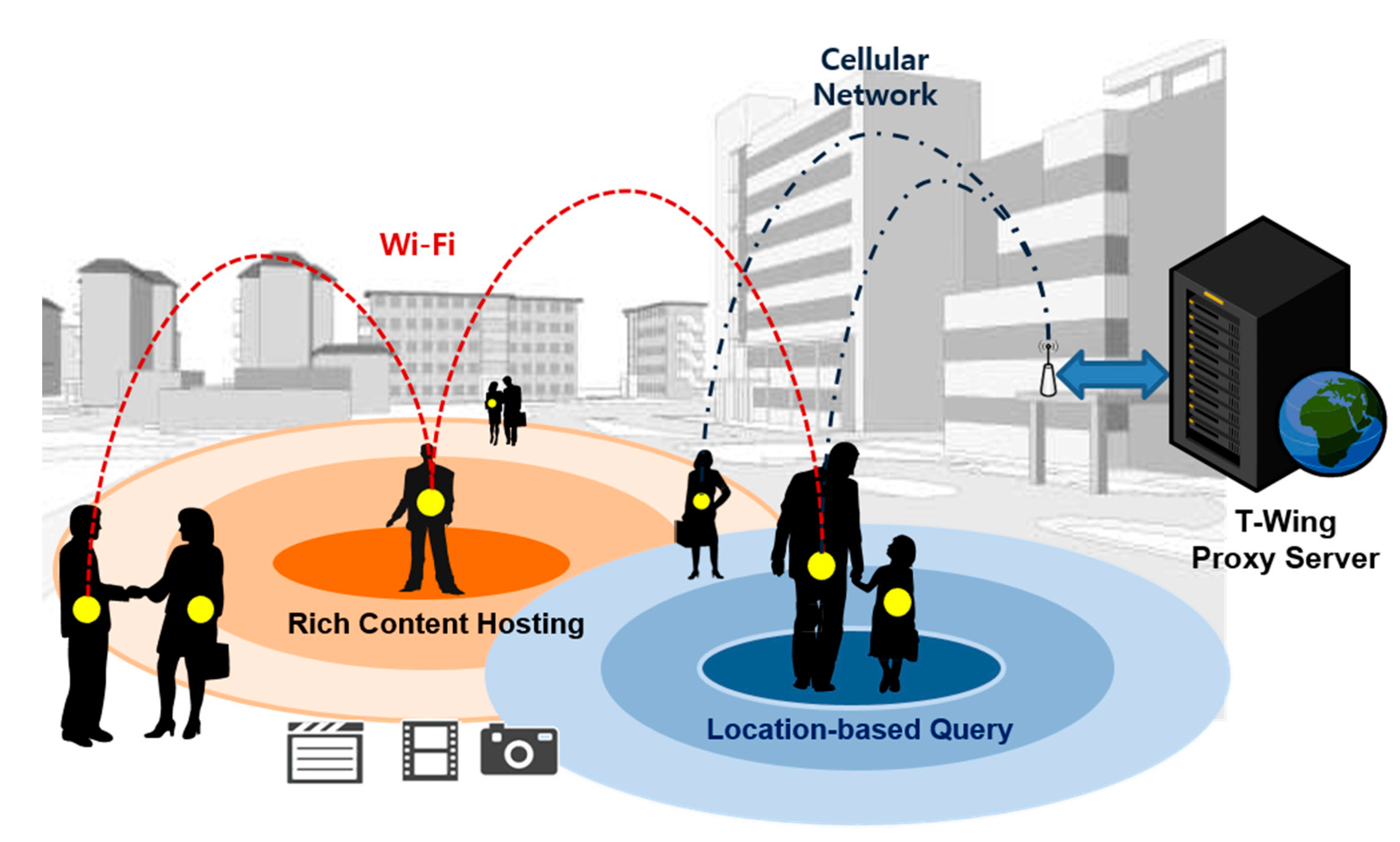

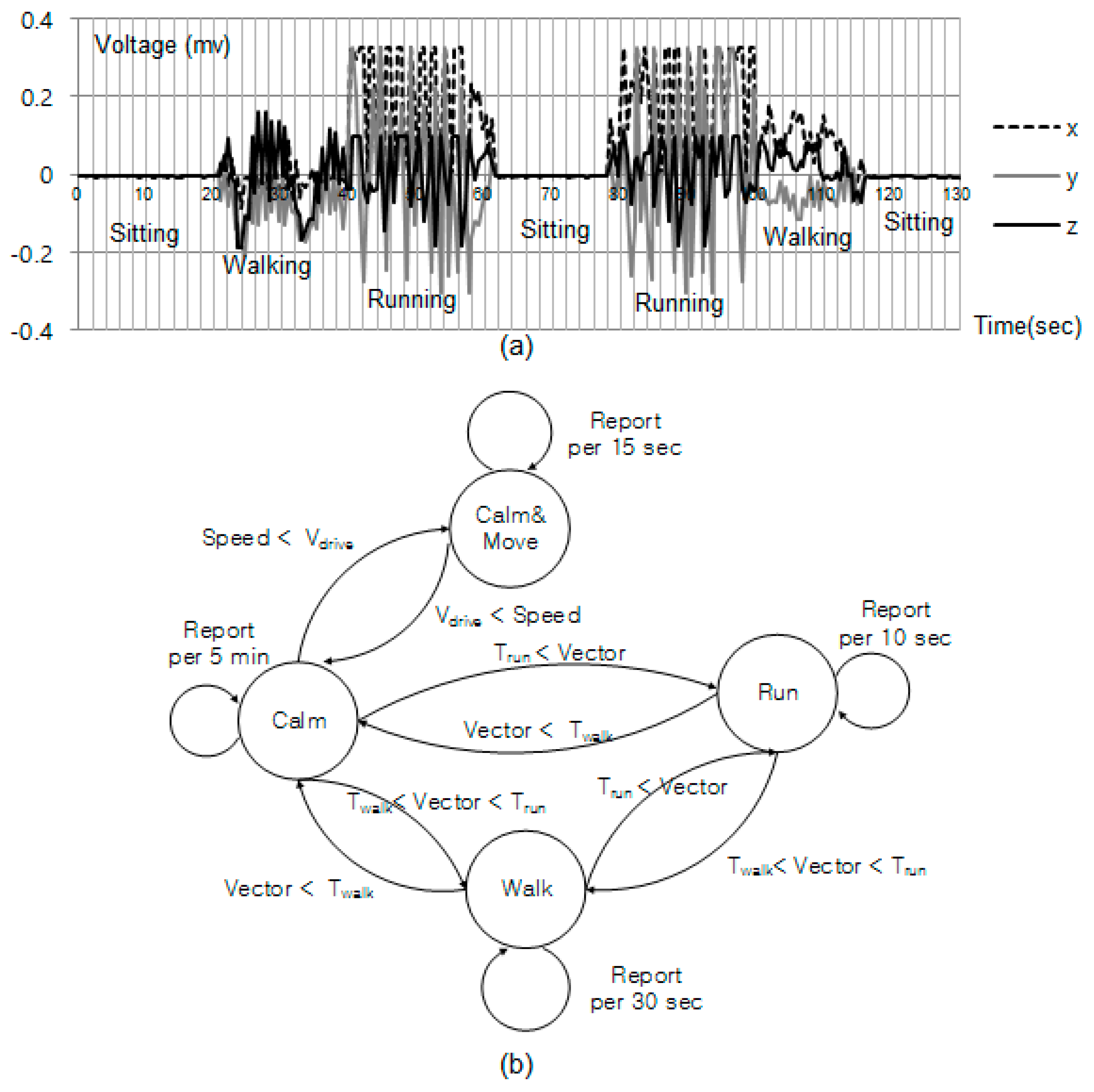



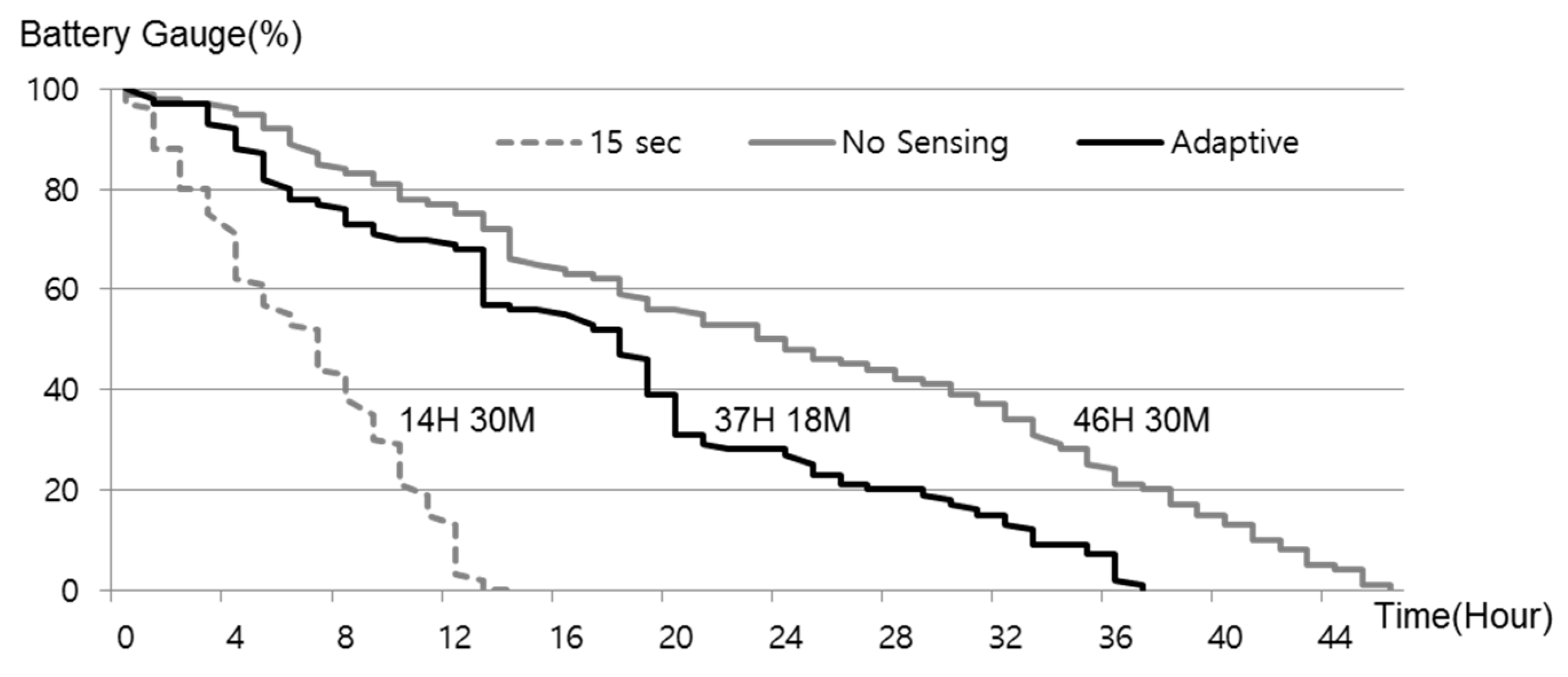
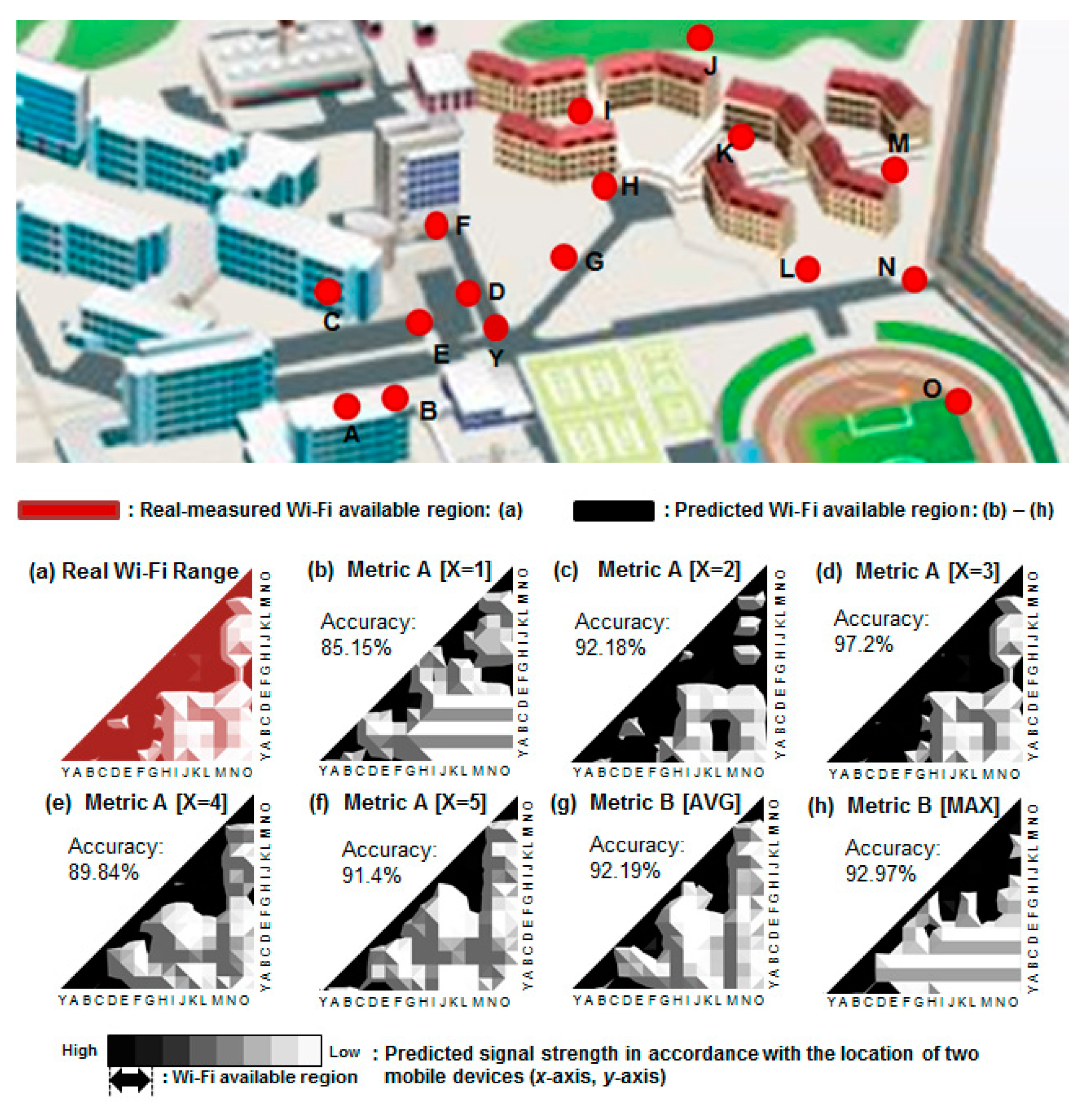
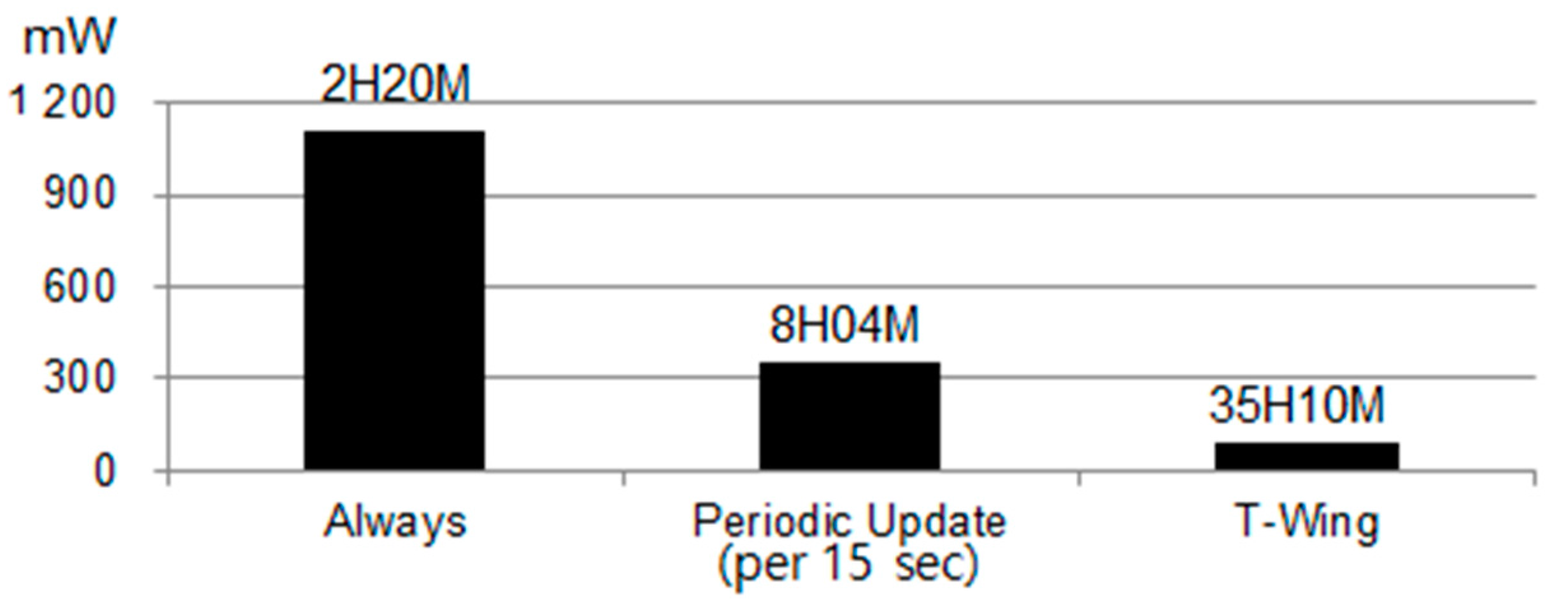

| Content Type | Compression Strategy |
|---|---|
| Text | Compression by LZO |
| Image | Trans-encode image to 640 × 280 |
| Audio | Full audio file → cutting up first 5 s |
| Video | Full video file → cutting up first 5 s → trans-encode from .wmv to animated .gif |
| Cellular | Wi-Fi | Power Consumption |
|---|---|---|
| Off | Off | 23.17 mW |
| On | Off | 31.82 mW |
| On (Send/Recv) | Off | 358.27 mW |
| On | On (Broadcast) | 1107.84 mW |
| On | On (Connected) | 398.27 mW |
| On | On (Send/Recv) | 1319.29 mW |
© 2017 by the authors. Licensee MDPI, Basel, Switzerland. This article is an open access article distributed under the terms and conditions of the Creative Commons Attribution (CC BY) license (http://creativecommons.org/licenses/by/4.0/).
Share and Cite
Park, K.-W.; Lee, Y.; Baek, S.H. Energy-Efficient Hosting Rich Content from Mobile Platforms with Relative Proximity Sensing. Sensors 2017, 17, 1828. https://doi.org/10.3390/s17081828
Park K-W, Lee Y, Baek SH. Energy-Efficient Hosting Rich Content from Mobile Platforms with Relative Proximity Sensing. Sensors. 2017; 17(8):1828. https://doi.org/10.3390/s17081828
Chicago/Turabian StylePark, Ki-Woong, Younho Lee, and Sung Hoon Baek. 2017. "Energy-Efficient Hosting Rich Content from Mobile Platforms with Relative Proximity Sensing" Sensors 17, no. 8: 1828. https://doi.org/10.3390/s17081828






